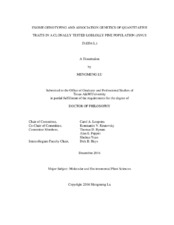| dc.description.abstract | Loblolly pine (Pinus taeda L.) is one of the most widely planted and commercially important forest tree species in the USA and worldwide. However, whole genome resequencing in loblolly pine is hampered by its size and complexity. Additionally, the genetics underlying quantitative traits of loblolly pine remains to be discovered. As a valid and more feasible alternative, entire exome sequencing was hence employed to identify the gene-associated single nucleotide polymorphisms (SNPs) and to genotype the 375 tress in a clonally tested loblolly pine population. Adaptive and growth traits were also measured and analyzed on this population.
The exome capture efficiency was high. A total of 972,720 high quality SNPs were identified after filtering. We found that linkage disequilibrium (LD) decayed very rapidly within this population. Two main distinct clusters representing western and eastern parts of the loblolly pine range were demonstrated by the population structure analysis using unlinked SNPs. Under a relaxed filtering condition, over 2.8 million SNP markers were used to test for single locus associations, SNP-SNP interactions and correlation of individual heterozygosity with phenotypic traits. Genetic correlations between traits as well as geographical variation exist within this population. A total of 36 SNP-trait associations were found for specific leaf area (5 SNPs), branch angle (2), crown width (3), stem diameter (4), total height (9), carbon isotope discrimination (4), nitrogen concentration (2), and pitch canker resistance (7). Eleven SNP-SNP interactions were found to be associated with branch angle (1 SNP-SNP interaction), crown width (2), total height (2), carbon isotope discrimination (2), nitrogen concentration (1), and pitch canker resistance (3). Non-additive effects imposed by dominance and epistasis compose a large fraction of the genetic variance for the quantitative traits. Candidate genes that underlie these traits have a wide spectrum of functions.
The obtained results demonstrated the efficiency of exome capture for genotyping species such as loblolly pine with a large and complex genome. Multiple effects that influence the performance of loblolly pines identified in this study provide great resources for understanding the genetic control of complex traits, and have potential value for breeding through maker assisted selection and genomic selection. | en |


